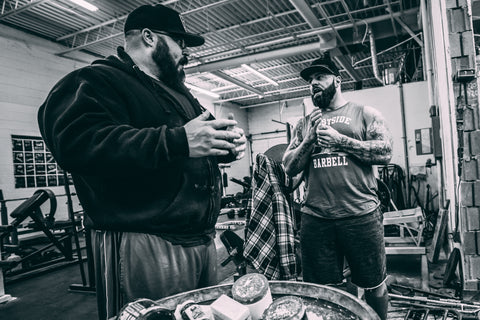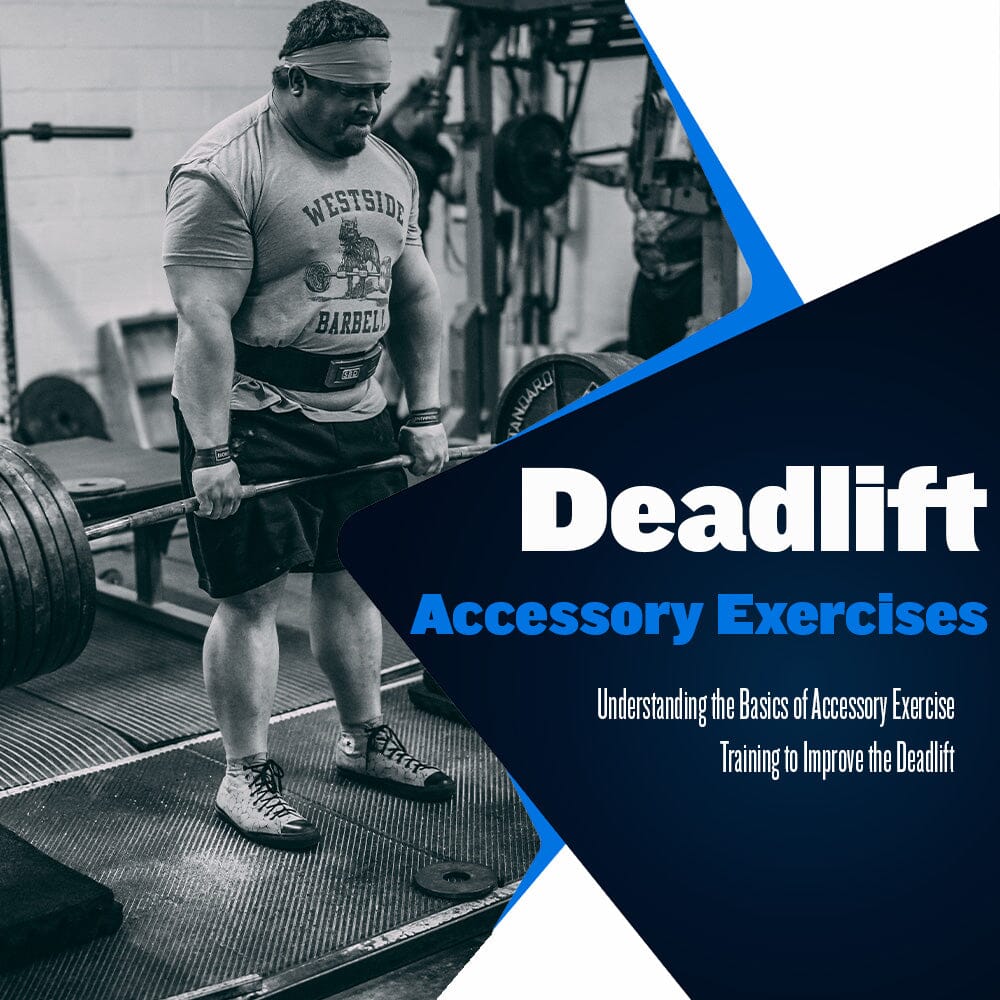Starting Conjugate: Deadlift Accessory Exercises

The Conjugate Method provides full-spectrum strength training, improving absolute strength, explosive power, work capacity, and muscle mass. This is done through the execution of max effort, dynamic effort, and repeated effort resistance training. The goal of any Conjugate Method-based training program is to provide an athlete with optimal training leading to consistent and predictable improvements in sports performance.
Unlike linear-based periodization, the Conjugate Method avoids detraining by eliminating specifically focused training blocks in favor of using multiple strength training methodologies simultaneously. With linear-based training, detraining causes performance to chart in a peaks and valleys pattern instead of the stair-step pattern associated with Conjugate-based training.
While much focus is placed on max effort and dynamic effort training, the repeated effort method is just as important to an athlete’s development. Repeated effort training refers to using submaximal weights for multiple sets and reps. In most Conjugate-based training programs, this method applies to accessory exercise training. Just as max and dynamic effort training are essential, repeated effort method training is equally vital to an athlete’s training.
Without appropriately selected accessory exercises, athletes risk current weaknesses becoming exacerbated while increasing the likelihood of injury as time passes. As we know, weak things break, and weak muscles become strained or torn if not sufficiently addressed.
The deadlift can be a particularly unforgiving exercise for the unprepared athlete. As much as it is important to develop absolute and explosive lower body strength, using repeated effort training to correct current weaknesses and build more muscle mass is just as important.
At Westside, we have tested, retested, and tested again almost all of the lower body exercises that transfer to the deadlift. Below, I will go over a few of the exercises we consider most valuable when focusing on improving deadlift strength:
Primary Accessory Exercises
First, I will quickly explain what a primary accessory exercise is. The primary accessory exercise of a training day will always be a multi-joint movement performed for at least three repetitions, but no more than eight repetitions, with training intensity regulated according to the set and rep scheme. For more information on primary accessory exercises, check out this article.
The deadlift-focused primary accessory exercises will feature a few deadlift variations, along with a few additional exercises that have tremendous carryover to the deadlift. Here are the go-to primary accessory exercises we use to improve our deadlift strength at Westside Barbell:
Deficit Deadlift - the deficit deadlift does a great job of developing posterior chain strength, specifically focusing on the glutes and hamstrings, while improving starting strength in the deadlift. If you are an athlete with posterior chain weakness or struggle with getting the deadlift off the floor, this exercise can solve those problems.
Rack Pull - this exercise focuses on joint angle-specific weakness while building tremendous strength and muscle mass. Over the years, the rack pull has received a bad rap due to the amount of noise the exercise can cause and the hatred most gym owners have for it. However, if you have a specific joint angle causing your deadlift to suffer, there is no better exercise to focus on and correct the current issue.
Giant Cambered Bar Good Morning - the GCB good morning is one of the best exercises to improve posterior chain strength, specifically the low back, glutes, and hamstrings. Aside from the muscle groups the movement targets, the good morning also trains a similar motor pattern to the deadlift. This allows athletes to target muscle groups involved in the deadlift without dealing with the recovery times associated with regular deadlifting.
Romanian Deadlift - the Romanian deadlift is an excellent deadlift variation to target the low back, glutes, and hamstrings. Out of the four primary-accessory exercises listed, this movement may be the most beneficial and provides the most carryover to your deadlift strength. The only issue with Romanian deadlifts is the risk of injury if programmed or performed wrong. Be sure to load the barbell appropriately and focus on the proper execution of each rep.
All exercises above should be performed immediately after the main exercise of the training day. As far as programming goes, we recommend programming each exercise for 3-5 sets of 5-8 reps. We will occasionally perform multiple sets of three reps if it makes sense, depending on where we are in our training.
Secondary Accessory Exercises
As you likely have already assumed, secondary accessory exercises are the accessory exercises that follow the primary accessory exercise. Unlike the primary accessory exercise, where movements are limited to multi-joint only, secondary accessory exercises include multi- and single-joint movements.
These movements focus on increasing muscle mass and, more specifically, bringing up lesser-developed muscle groups. While primary accessory exercises lean more towards strengthening muscle groups, secondary accessory exercises typically focus on increasing muscle mass and improving overall composition.
Here are some of the secondary accessory exercises we use at Westside Barbell to target muscle groups involved in the deadlift:
Barbell Rows - in terms of building the size and strength of the back, barbell rows are only outdone by heavy deadlifts. However, the benefit of barbell rows is that you can use them regularly, while heavy deadlifts lead to extended recovery times. Not only will barbell rows make you a better deadlifter, but you’ll also become a stronger lifter overall.
Inverse Curl - the Inverse Curl machine creates hamstrings of steel. This exercise allows athletes to perform assisted glute-ham raises, allowing athletes of any ability level to benefit from glute-ham raises. For the athlete already able to perform normal glute-ham raises, the Inverse Curl allows them to train at a higher volume level. For the athlete who struggles with glute-ham raises, this machine allows these athletes to benefit from one of the best posterior chain exercises.
Trap Bar Deadlift - this exercise could be included as a primary accessory exercise. However, it will often be used as a secondary accessory exercise programmed at a higher level of training volume. The trap bar deadlift is a great way to train and improve leg drive in the deadlift. With the handles at the side of the implement, forward torso lean is reduced, giving the athlete a joint angle advantage and the ability to lift heavier weights for more reps.
SSB Good Morning - we use this exercise to target the mid and upper back, glutes, and hamstrings. Unlike the giant cambered bar, where the burden is placed mainly on the low back, hips, glutes, and hamstrings, the SSB significantly burdens the mid and upper torso. Considering this, we typically train this exercise using a set and rep scheme that lowers the overall training intensity, reducing shearing force on the spine and the chance of injury.
All exercises above should be performed immediately after the primary accessory exercise. In terms of programming, these exercises should be performed for 2-4 sets of 8-10, 10-12, or 12-15 reps.
Nothing New Under the Sun
The exercises mentioned above represent old-school movements mixed with new-school training tools. For instance, the good morning has been around for years; we add specialty bars to the mix to alter the training effect. Same as the glute-ham raise is an old-school movement, but Lou developed the Inverse Curl allowing anyone to benefit from the exercise.
The idea is not to create the newest exercise; we want to take the exercises and motor patterns we know to be most beneficial and find ways to manipulate the training effect to maximize gains in strength and muscle mass. Social media coaches follow trends, while real strength and conditioning coaches stick to what works.
Remember, just because a new exercise is posted on social media doesn’t mean it is worth anything. Too often, individuals make significant changes to their programming to keep up with what they perceive to be the cutting edge of strength training knowledge. Meanwhile, the only reason they’re seeing the “new” movement in the first place is because some online influencer is short on content for the day.
The basics will never fail you. I have been training for over 20 years, and most of the exercises I use are old-school movements with variations added as needed to allow progress to continue. This has allowed me to make predictable gains in strength and have quick routes back to strength whenever I have been injured.
The real trick is finding the movements that an athlete responds best to, mastering the execution of these movements, and then finding ways to alter the movement further once the rate of improvement begins to slow. Once this level of understanding is achieved, athletes will make gains in strength year after year.
Sources:
Simmons, L. (2007). Westside Barbell Book of Methods. Westside Barbell.
Verkhoshansky, Y., & Siff, M. C. (2009). Supertraining. Verkhoshansky.





